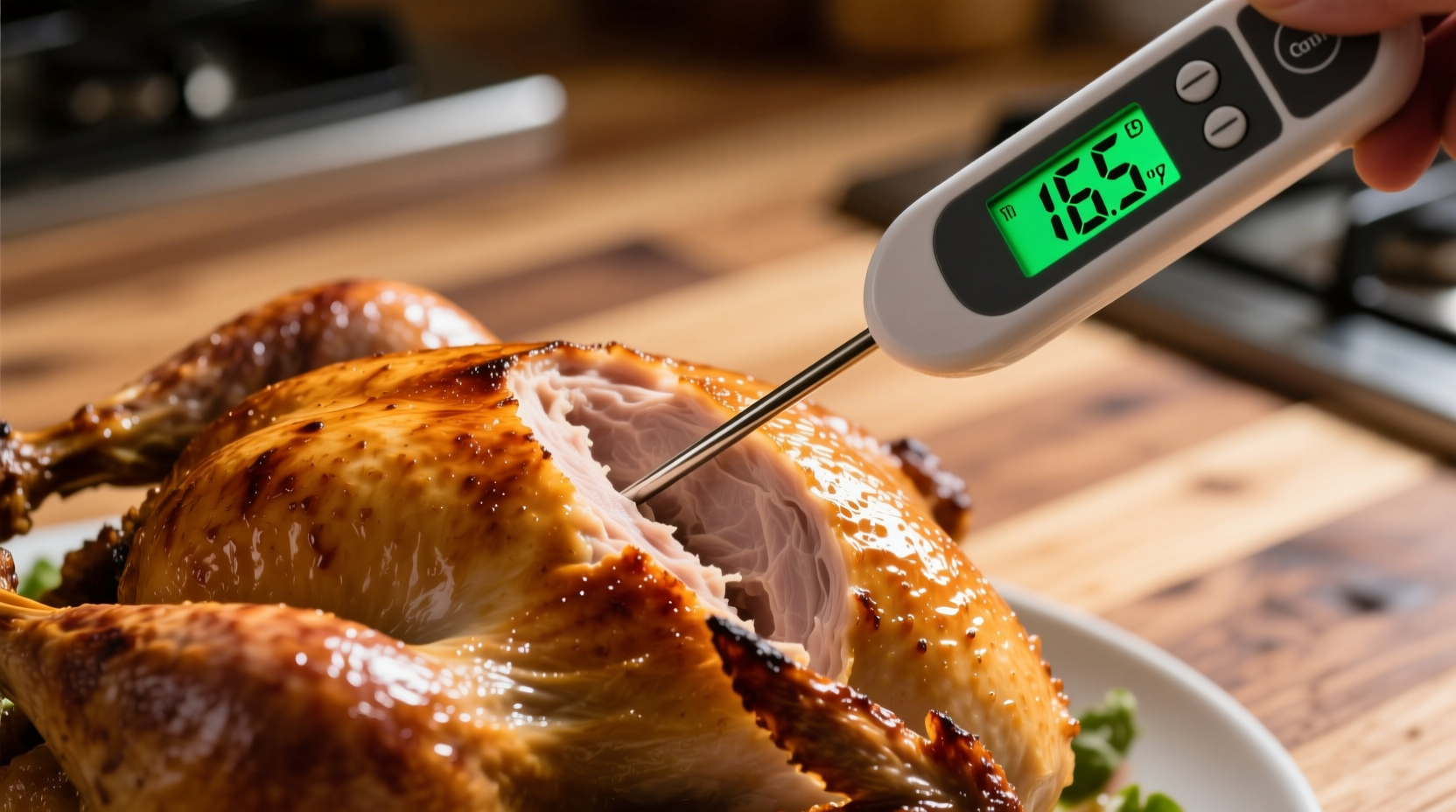Nothing ruins a holiday meal faster than undercooked turkey or dry, overcooked bird. Getting the temperature right isn't just about flavor—it's a critical food safety requirement. This guide delivers precise cooking temperatures based on USDA Food Safety and Inspection Service standards, plus practical techniques professional chefs use to achieve perfectly cooked turkey every time.
Why Temperature Matters: Beyond Just Doneness
Turkey must reach 165°F (74°C) to destroy Salmonella and Campylobacter bacteria commonly found in poultry. Unlike beef, turkey has virtually no fat marbling to protect against bacterial contamination, making accurate temperature measurement non-negotiable. The USDA's Food Safety and Inspection Service confirms this minimum internal temperature through extensive testing documented in their Poultry Cooking Guidelines.
Your Two Critical Temperature Measurements
Confusion often arises between oven temperature and internal meat temperature. Understanding both is essential:
| Temperature Type | Recommended Setting | Purpose |
|---|---|---|
| Oven Temperature | 325°F (163°C) | Even cooking without burning exterior |
| Internal Meat Temperature | 165°F (74°C) | Food safety standard for pathogen elimination |
Step-by-Step Temperature Management Timeline
Pre-Cooking Phase: Setting Up for Success
Remove turkey from refrigerator 1 hour before cooking to reduce temperature gradient. Place oven rack in lower third position and preheat to 325°F (163°C). Insert oven thermometer to verify actual temperature—many ovens have calibration issues. For accurate readings, use a digital instant-read thermometer rather than the pop-up indicators included with most turkeys, which trigger at 180°F (82°C), often resulting in dry meat.
Cooking Phase: Monitoring Critical Stages
Cooking time varies by weight (approximately 13 minutes per pound at 325°F). During cooking:
- Check temperature starting 45 minutes before expected finish time
- Measure in three locations: breast, inner thigh, wing joint
- Insert thermometer into thickest part without touching bone
- Continue cooking if any reading is below 165°F (74°C)

Resting Phase: The Temperature Final Frontier
After reaching 165°F (74°C), remove turkey and let rest 20-30 minutes. During this critical phase, residual heat continues cooking the meat (carryover cooking), raising internal temperature 5-10°F while allowing juices to redistribute. Cutting too soon releases moisture, resulting in dry turkey. This resting period is especially important when cooking at higher temperatures (350°F+).
Special Circumstances and Temperature Adjustments
Certain preparation methods require temperature awareness:
Stuffed Turkeys: Higher Risk, Higher Temperature
When cooking stuffed turkey, ensure both turkey AND stuffing reach 165°F (74°C). The dense stuffing creates a bacterial risk zone, requiring extended cooking time. Many food safety experts recommend cooking stuffing separately to avoid undercooked poultry or overcooked bird.
Brined Turkeys: Temperature Nuances
Brining draws moisture into the meat, which affects heat transfer. Brined turkeys may cook slightly faster and show false temperature readings early in cooking due to salt content. Always verify final temperature in multiple locations.
Smoked or Low-Temperature Cooking
When smoking turkey at lower temperatures (225-250°F), the extended cooking time requires careful monitoring. Maintain smoke temperature between 225-250°F while ensuring internal meat still reaches 165°F (74°C). The USDA's Smoking Whole Poultry Guidelines provide specific parameters for this method.
Common Temperature Mistakes to Avoid
- Guessing doneness by color or juice clarity (unreliable indicators)
- Single-point temperature checks (always check multiple locations)
- Not calibrating thermometers (test in ice water: should read 32°F/0°C)
- Cutting too soon after reaching target temperature
- Over-relying on pop-up timers (often trigger too late)
Temperature Verification: Tools and Techniques
Invest in a quality digital thermometer with a thin probe for accurate readings. The Thermapen ONE, recommended by the American Test Kitchen, provides readings in 3-4 seconds. For continuous monitoring during roasting, consider an oven-safe probe thermometer with external display. Always clean thermometer probes with hot, soapy water between measurements to prevent cross-contamination.
Frequently Asked Questions
Can turkey be safe at 160 degrees?
While 160°F (71°C) begins killing bacteria, the USDA requires 165°F (74°C) as the minimum safe temperature for immediate consumption. At 160°F, turkey would need to maintain that temperature for over 30 seconds to achieve the same pathogen reduction as 165°F instantly.
Where exactly should I check the turkey temperature?
Check three critical locations: the inner thigh (without touching bone), the thickest part of the breast, and where the wing meets the body. These areas cook at different rates, with the breast typically finishing before dark meat.
How long after reaching 165 degrees should I wait before serving?
Allow turkey to rest for 20-30 minutes after reaching 165°F. This resting period enables carryover cooking (temperature rises 5-10°F) and allows juices to redistribute, preventing dry meat when carving.
Does a higher oven temperature cook turkey faster without drying it out?
Starting at 425°F for 30 minutes then reducing to 325°F can create crispy skin while protecting moisture, but exceeding 350°F risks uneven cooking. The critical factor is internal temperature, not oven setting—always verify with a thermometer regardless of cooking method.











 浙公网安备
33010002000092号
浙公网安备
33010002000092号 浙B2-20120091-4
浙B2-20120091-4